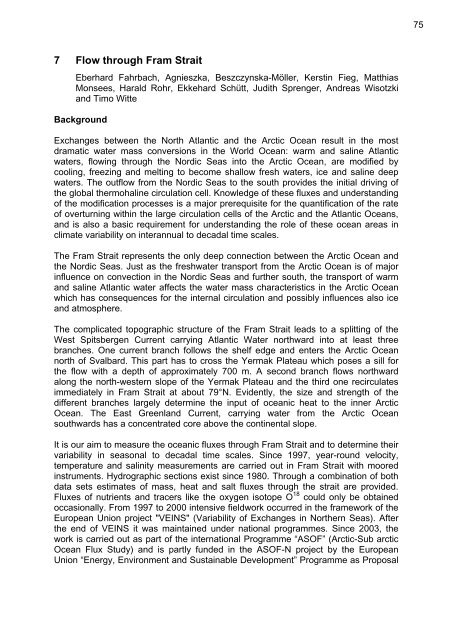the Expedition ARKTIS-XIX/4 of the research vessel POLARSTERN ...
the Expedition ARKTIS-XIX/4 of the research vessel POLARSTERN ...
the Expedition ARKTIS-XIX/4 of the research vessel POLARSTERN ...
You also want an ePaper? Increase the reach of your titles
YUMPU automatically turns print PDFs into web optimized ePapers that Google loves.
7 Flow through Fram Strait<br />
Eberhard Fahrbach, Agnieszka, Beszczynska-Möller, Kerstin Fieg, Matthias<br />
Monsees, Harald Rohr, Ekkehard Schütt, Judith Sprenger, Andreas Wisotzki<br />
and Timo Witte<br />
Background<br />
Exchanges between <strong>the</strong> North Atlantic and <strong>the</strong> Arctic Ocean result in <strong>the</strong> most<br />
dramatic water mass conversions in <strong>the</strong> World Ocean: warm and saline Atlantic<br />
waters, flowing through <strong>the</strong> Nordic Seas into <strong>the</strong> Arctic Ocean, are modified by<br />
cooling, freezing and melting to become shallow fresh waters, ice and saline deep<br />
waters. The outflow from <strong>the</strong> Nordic Seas to <strong>the</strong> south provides <strong>the</strong> initial driving <strong>of</strong><br />
<strong>the</strong> global <strong>the</strong>rmohaline circulation cell. Knowledge <strong>of</strong> <strong>the</strong>se fluxes and understanding<br />
<strong>of</strong> <strong>the</strong> modification processes is a major prerequisite for <strong>the</strong> quantification <strong>of</strong> <strong>the</strong> rate<br />
<strong>of</strong> overturning within <strong>the</strong> large circulation cells <strong>of</strong> <strong>the</strong> Arctic and <strong>the</strong> Atlantic Oceans,<br />
and is also a basic requirement for understanding <strong>the</strong> role <strong>of</strong> <strong>the</strong>se ocean areas in<br />
climate variability on interannual to decadal time scales.<br />
The Fram Strait represents <strong>the</strong> only deep connection between <strong>the</strong> Arctic Ocean and<br />
<strong>the</strong> Nordic Seas. Just as <strong>the</strong> freshwater transport from <strong>the</strong> Arctic Ocean is <strong>of</strong> major<br />
influence on convection in <strong>the</strong> Nordic Seas and fur<strong>the</strong>r south, <strong>the</strong> transport <strong>of</strong> warm<br />
and saline Atlantic water affects <strong>the</strong> water mass characteristics in <strong>the</strong> Arctic Ocean<br />
which has consequences for <strong>the</strong> internal circulation and possibly influences also ice<br />
and atmosphere.<br />
The complicated topographic structure <strong>of</strong> <strong>the</strong> Fram Strait leads to a splitting <strong>of</strong> <strong>the</strong><br />
West Spitsbergen Current carrying Atlantic Water northward into at least three<br />
branches. One current branch follows <strong>the</strong> shelf edge and enters <strong>the</strong> Arctic Ocean<br />
north <strong>of</strong> Svalbard. This part has to cross <strong>the</strong> Yermak Plateau which poses a sill for<br />
<strong>the</strong> flow with a depth <strong>of</strong> approximately 700 m. A second branch flows northward<br />
along <strong>the</strong> north-western slope <strong>of</strong> <strong>the</strong> Yermak Plateau and <strong>the</strong> third one recirculates<br />
immediately in Fram Strait at about 79°N. Evidently, <strong>the</strong> size and strength <strong>of</strong> <strong>the</strong><br />
different branches largely determine <strong>the</strong> input <strong>of</strong> oceanic heat to <strong>the</strong> inner Arctic<br />
Ocean. The East Greenland Current, carrying water from <strong>the</strong> Arctic Ocean<br />
southwards has a concentrated core above <strong>the</strong> continental slope.<br />
It is our aim to measure <strong>the</strong> oceanic fluxes through Fram Strait and to determine <strong>the</strong>ir<br />
variability in seasonal to decadal time scales. Since 1997, year-round velocity,<br />
temperature and salinity measurements are carried out in Fram Strait with moored<br />
instruments. Hydrographic sections exist since 1980. Through a combination <strong>of</strong> both<br />
data sets estimates <strong>of</strong> mass, heat and salt fluxes through <strong>the</strong> strait are provided.<br />
Fluxes <strong>of</strong> nutrients and tracers like <strong>the</strong> oxygen isotope O 18 could only be obtained<br />
occasionally. From 1997 to 2000 intensive fieldwork occurred in <strong>the</strong> framework <strong>of</strong> <strong>the</strong><br />
European Union project "VEINS" (Variability <strong>of</strong> Exchanges in Nor<strong>the</strong>rn Seas). After<br />
<strong>the</strong> end <strong>of</strong> VEINS it was maintained under national programmes. Since 2003, <strong>the</strong><br />
work is carried out as part <strong>of</strong> <strong>the</strong> international Programme “ASOF” (Arctic-Sub arctic<br />
Ocean Flux Study) and is partly funded in <strong>the</strong> ASOF-N project by <strong>the</strong> European<br />
Union “Energy, Environment and Sustainable Development” Programme as Proposal<br />
75

















